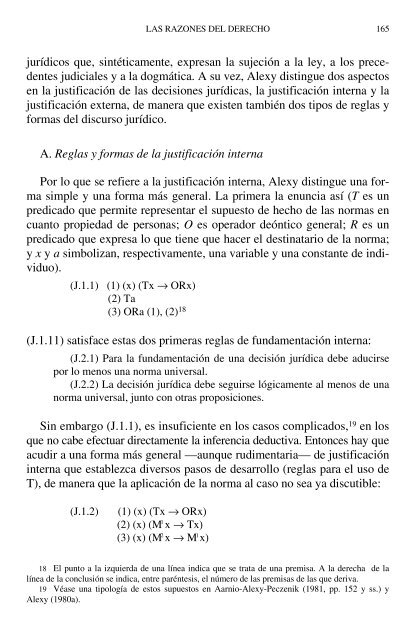LAS RAZONES DEL DERECHO Teo rías de la ar gu men ta ción ju rí di ca
Create successful ePaper yourself
Turn your PDF publications into a flip-book with our unique Google optimized e-Paper software.
<strong>LAS</strong> <strong>RAZONES</strong> <strong>DEL</strong> <strong>DERECHO</strong> 165<br />
<strong>ju</strong><strong>rí</strong><strong>di</strong>cos que, sintéti<strong>ca</strong><strong>men</strong>te, expresan <strong>la</strong> suje<strong>ción</strong> a <strong>la</strong> ley, a los prece<strong>de</strong>ntes<br />
<strong>ju</strong><strong>di</strong>ciales y a <strong>la</strong> dogmáti<strong>ca</strong>. A su vez, Alexy <strong>di</strong>stin<strong>gu</strong>e dos aspectos<br />
en <strong>la</strong> <strong>ju</strong>stifi<strong>ca</strong><strong>ción</strong> <strong>de</strong> <strong>la</strong>s <strong>de</strong>cisiones <strong>ju</strong><strong>rí</strong><strong>di</strong><strong>ca</strong>s, <strong>la</strong> <strong>ju</strong>stifi<strong>ca</strong><strong>ción</strong> interna y <strong>la</strong><br />
<strong>ju</strong>stifi<strong>ca</strong><strong>ción</strong> externa, <strong>de</strong> manera que existen <strong>ta</strong>mbién dos tipos <strong>de</strong> reg<strong>la</strong>s y<br />
formas <strong>de</strong>l <strong>di</strong>scurso <strong>ju</strong><strong>rí</strong><strong>di</strong>co.<br />
A. Reg<strong>la</strong>s y formas <strong>de</strong> <strong>la</strong> <strong>ju</strong>stifi<strong>ca</strong><strong>ción</strong> interna<br />
Por lo que se refiere a <strong>la</strong> <strong>ju</strong>stifi<strong>ca</strong><strong>ción</strong> interna, Alexy <strong>di</strong>stin<strong>gu</strong>e una forma<br />
simple y una forma más general. La primera <strong>la</strong> enuncia así (T es un<br />
pre<strong>di</strong><strong>ca</strong>do que permite represent<strong>ar</strong> el supuesto <strong>de</strong> hecho <strong>de</strong> <strong>la</strong>s normas en<br />
cuanto propiedad <strong>de</strong> personas; O es operador <strong>de</strong>óntico general; R es un<br />
pre<strong>di</strong><strong>ca</strong>do que expresa lo que tiene que hacer el <strong>de</strong>stinat<strong>ar</strong>io <strong>de</strong> <strong>la</strong> norma;<br />
y x y a simbolizan, respectiva<strong>men</strong>te, una v<strong>ar</strong>iable y una cons<strong>ta</strong>nte <strong>de</strong> in<strong>di</strong>viduo).<br />
(J.1.1) (1) (x) (Tx → ORx)<br />
(2) Ta<br />
(3) ORa (1), (2) 18<br />
(J.1.11) satisface es<strong>ta</strong>s dos primeras reg<strong>la</strong>s <strong>de</strong> funda<strong>men</strong><strong>ta</strong><strong>ción</strong> interna:<br />
(J.2.1) P<strong>ar</strong>a <strong>la</strong> funda<strong>men</strong><strong>ta</strong><strong>ción</strong> <strong>de</strong> una <strong>de</strong>cisión <strong>ju</strong><strong>rí</strong><strong>di</strong><strong>ca</strong> <strong>de</strong>be aducirse<br />
por lo <strong>men</strong>os una norma universal.<br />
(J.2.2) La <strong>de</strong>cisión <strong>ju</strong><strong>rí</strong><strong>di</strong><strong>ca</strong> <strong>de</strong>be se<strong>gu</strong>irse lógi<strong>ca</strong><strong>men</strong>te al <strong>men</strong>os <strong>de</strong> una<br />
norma universal, <strong>ju</strong>nto con otras proposiciones.<br />
Sin emb<strong>ar</strong>go (J.1.1), es insuficiente en los <strong>ca</strong>sos compli<strong>ca</strong>dos, 19 en los<br />
que no <strong>ca</strong>be efectu<strong>ar</strong> <strong>di</strong>rec<strong>ta</strong><strong>men</strong>te <strong>la</strong> inferencia <strong>de</strong>ductiva. Entonces hay que<br />
acu<strong>di</strong>r a una forma más general —aunque ru<strong>di</strong><strong>men</strong>t<strong>ar</strong>ia— <strong>de</strong> <strong>ju</strong>stifi<strong>ca</strong><strong>ción</strong><br />
interna que es<strong>ta</strong>blez<strong>ca</strong> <strong>di</strong>versos pasos <strong>de</strong> <strong>de</strong>s<strong>ar</strong>rollo (reg<strong>la</strong>s p<strong>ar</strong>a el uso <strong>de</strong><br />
T), <strong>de</strong> manera que <strong>la</strong> apli<strong>ca</strong><strong>ción</strong> <strong>de</strong> <strong>la</strong> norma al <strong>ca</strong>so no sea ya <strong>di</strong>scutible:<br />
(J.1.2)<br />
(1) (x) (Tx → ORx)<br />
1<br />
(2) (x) (M x → Τx)<br />
2<br />
1<br />
(3) (x) (M x → Μ x)<br />
18 El punto a <strong>la</strong> izquierda <strong>de</strong> una línea in<strong>di</strong><strong>ca</strong> que se tra<strong>ta</strong> <strong>de</strong> una premisa. A <strong>la</strong> <strong>de</strong>recha <strong>de</strong> <strong>la</strong><br />
línea <strong>de</strong> <strong>la</strong> conclusión se in<strong>di</strong><strong>ca</strong>, entre p<strong>ar</strong>éntesis, el número <strong>de</strong> <strong>la</strong>s premisas <strong>de</strong> <strong>la</strong>s que <strong>de</strong>riva.<br />
19 Véase una tipología <strong>de</strong> estos supuestos en A<strong>ar</strong>nio-Alexy-Peczenik (1981, pp. 152 y ss.) y<br />
Alexy (1980a).



